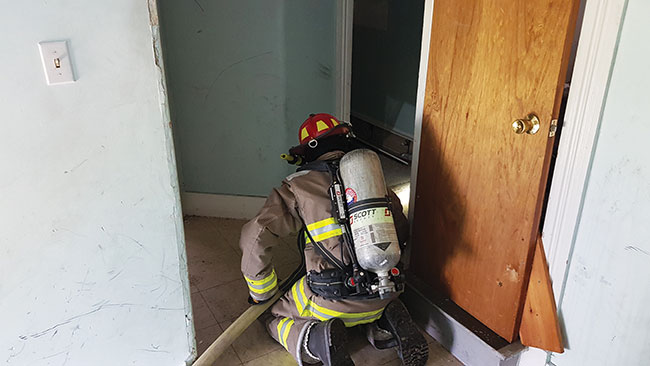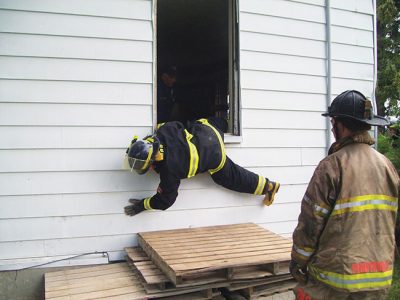
Back to basics: The four causes of disorientation
By Mark van der Feyst
Features editors pick Mark van der Feyst Maintain building orientation by always keeping contact with the hose line or wall.
Photo: Mark van der Feyst
Maintain building orientation by always keeping contact with the hose line or wall.
Photo: Mark van der Feyst We previously looked at SCBA emergencies with respect to firefighter survival, which leads us to our next area of focus: disorientation emergencies. Every firefighter can become disoriented inside a structure when performing interior operations, it is very easy to do. Some disoriented firefighters have made it out alive and some have not.
Let’s first look at why/how we become disoriented. The why aspect is answered by our need to see things or be able to visualize what we are doing. When we are blinded in a situation, we can no longer see or visualize what it is that we are dealing with. When we lose our ability to see, our minds cannot function normally as they should when we can see. This causes us to become “lost” within our own minds. If we couple that with being in a strange environment, we have a disorientation disaster waiting for us.
How do we become disoriented? There are four common causes as to how we become disoriented: loss of reference point, a fall due to partial collapse of the structure, a collapse of structural components and/or rapidly deteriorating interior conditions. Let’s explore these further.
A loss of reference point is the most common reason why disorientation occurs, and it is the easiest because every firefighter has the capability to lose their reference point. What does this mean? It means the firefighter took their hand or body part off the wall or they left the hose line! Redundancy is when we have fail- safes in place to protect us from harm. In the case of interior operations, the redundancy factor is the reference point of the building wall or the hose line that we bring in with us because it is always there. When we momentarily leave that point our minds lose the ability to know where we are and at that moment and we become disoriented. Most of the time, this will be the fault of the firefighter.
In the event of a fall due to a partial collapse of a structure, a firefighter falls from one area to another because the structure has partially fallen away or is collapsing in certain areas. Once a firefighter falls through a floor below, they have lost their reference point and default back to their previous point. The firefighter has now lost their reference point. The falling through the floor is not the firefighter’s fault, it is the building’s fault. Avoiding the fall is what we try to do by sounding or feeling the floor in front of us as we navigate along.
During a collapse of structural components, the building is failing and collapse is occurring. Once this happens, the reference point disappears from the firefighter rendering the firefighter lost. Once this happens, we are defaulting back to point number one.
When there are rapidly deteriorating interior conditions, the situation becomes similar to the previous point but with conditions being the main focal point. The firefighter will be experiencing a flashover, backdraft, smoke explosion or a rapid-fire event. When this happens, the firefighter may lose their point of reference and become disoriented.
Now that we have identified the common reasons firefighters becomes disoriented, what can they do to help themselves when lost?

Locate an exterior opening and perform an emergency escape maneuver.
Photo: Mark van der Feyst
The first thing to do is stop and gain control of the situation. This may sound easy, but it is not. Most firefighters want to do something right away to fix the situation. This is where they start to work against themselves, and at the same time, fatigue themselves in the process. By taking a timeout of about two to five seconds, the firefighter will be able to stop what they are doing, assess the situation and hopefully be able to take control of it.
This will take some practice to perfect because our natural sense is to react right away – fight or flight. When we have elevated heart rates, our cognitive processes and fine motor skills deteriorate. This is what hurts firefighters and where they work against themselves.
Secondly, do a quick size up of the situation. This is a part of the “time out” that the firefighter needs to take in order to get control of the situation. Sizing up the situation includes current air status, mobility impairments, environmental conditions, accountability of other crew members, etc. By gathering the information quickly, the firefighter will gain better control of the situation.
Thirdly, communicate with your fellow crew members or with Command. This is vitally important for the survival of the firefighter, especially notifying Command. When you communicate the need for help with Command, the sequence of the RIT operation can be initiated quickly. A delay in notifying Command will mean a delay in help being dispatched. This is where the mayday call comes in.
The fourth thing that can be done is to search for a reference point. In order for firefighters to rescue themselves from the situation that they are in, they will need to quickly reorient themselves. This will involve finding a new reference point such as a wall, hose line, window, door, etc. By doing this, they will be able to determine where they might be and hopefully use that new reference point to get themselves out. We will discuss this in more detail in the coming months.
The last thing that can be done is to execute an emergency escape. Once an exterior opening has been located, the firefighter can then perform an emergency escape maneuver such as a head first ladder dive, the hang and drop, window bail out with a rope system, or a hose slide. This will get the firefighter out of the building quickly and efficiently. We will dive into these in more detail a few months from now.
To reinforce the need to maintain building orientation is to train on it. The simplest drills can be conducted to do this with a focus on keeping the body to the building.
Mark van der Feyst is a full-time firefighter with the WFD, an author, international instructor and a trainer for the Pennsylvania State Fire Academy. Contact Mark at Mark@FireStarTraining.com.
Print this page